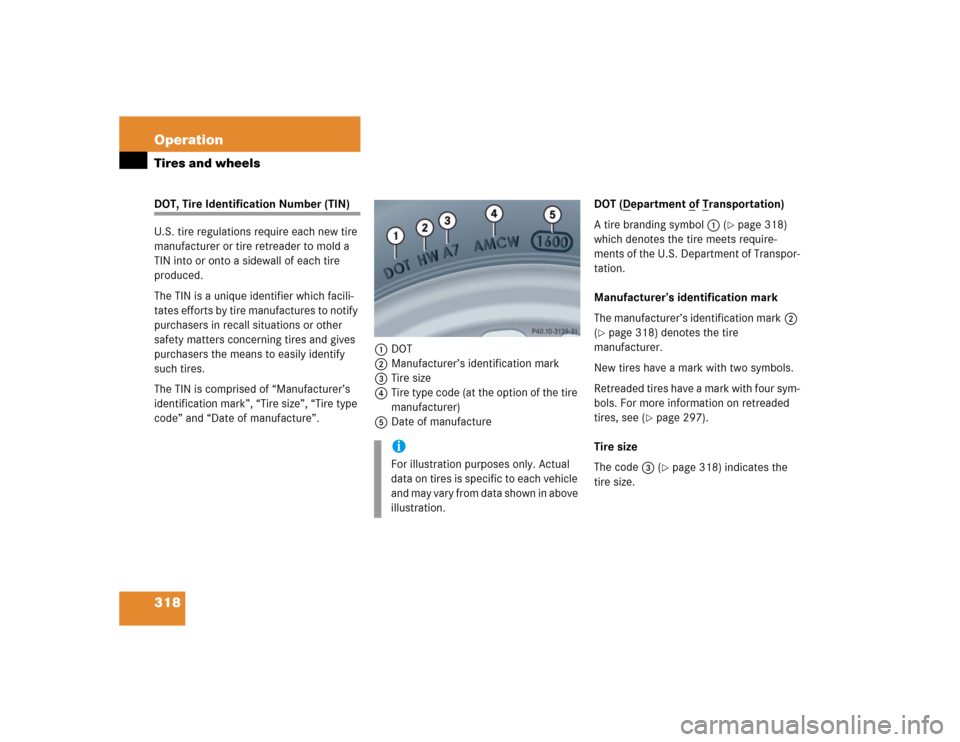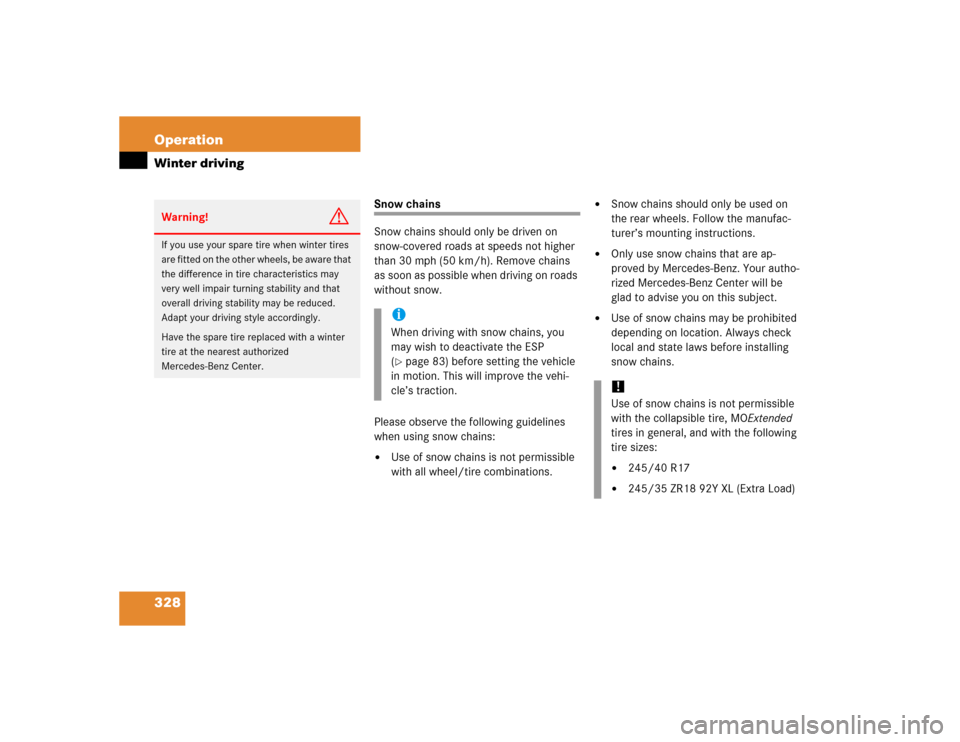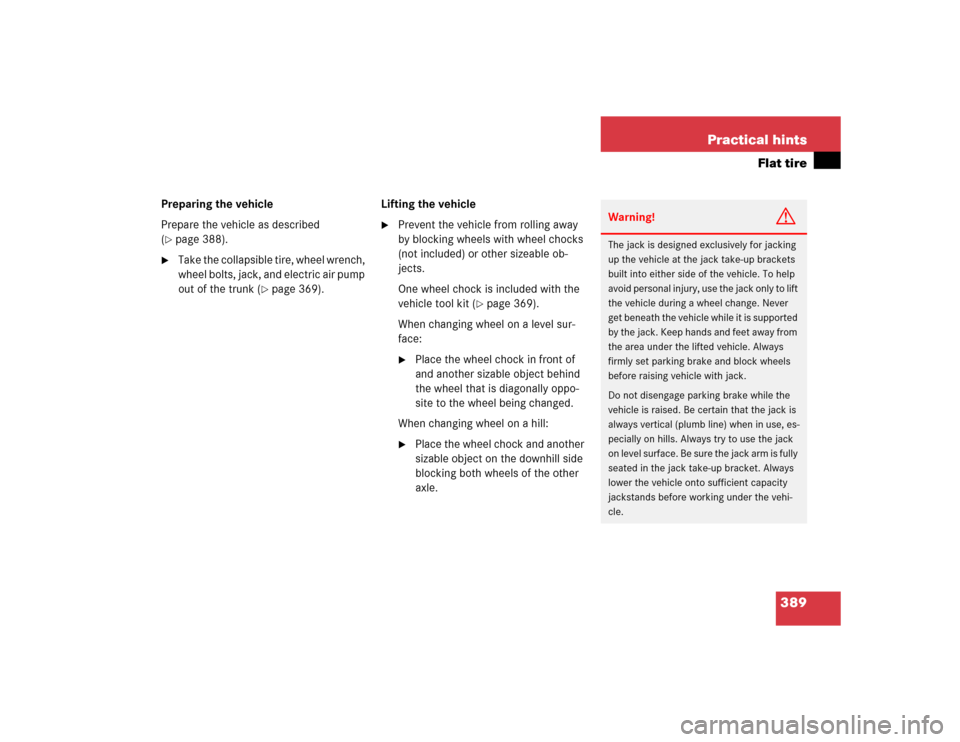Page 316 of 464

316 OperationTires and wheelsSummer tires�
At the tire manufacturer’s option, any
tire with a speed capability above
149 mph (240 km/h) can include a
“ZR” in the size designation (for exam-
ple: 245/40 ZR18). To determine the
maximum speed capability of the tire,
the service description for the tire must
be referred to.The service description is comprised of
the tire load rating5 (
�page 313)
and the tire speed rating6
(
�page 313).
If your tire includes “ZR” in the size
designation and no service
description5 and6 (
�page 313) is
given, the tire manufacturer must be
consulted for the maximum speed ca-
pability.
If a service description5 and6
(
�page 313) is given, the speed capa-
bility is limited by the speed symbol in
the service description.
Example: 245/40 ZR18 97Y.
In this example, “97Y” is the service
description. The letter “Y” designates
the speed rating and the speed capabil-
ity of the tire is limited to 186 mph
(300 km/h).
�
Any tire with a speed capability above
186 mph (300 km/h) must include a
“ZR” in the size designation AND the
service description must be placed in
parenthesis. Example: 275/40 ZR 18
(99Y). The “(Y)” speed rating in paren-
thesis designates the maximum speed
capability of the tire as being above
186 mph (300 km/h). Consult the tire
manufacturer for the actual maximum
permissible speed of the tire.
Index
Speed rating
Q
up to 100 mph (160 km/h)
R
up to 106 mph (170 km/h)
S
up to 112 mph (180 km/h)
T
up to 118 mph (190 km/h)
H
up to 130 mph (210 km/h)
V
up to 149 mph (240 km/h)
W
up to 168 mph (270 km/h)
Y
up to 186 mph (300 km/h)
(Y)
above 186 mph (300 km/h)
ZR
above 149 mph (240 km/h)
Page 318 of 464

318 OperationTires and wheelsDOT, Tire Identification Number (TIN)
U.S. tire regulations require each new tire
manufacturer or tire retreader to mold a
TIN into or onto a sidewall of each tire
produced.
The TIN is a unique identifier which facili-
tates efforts by tire manufactures to notify
purchasers in recall situations or other
safety matters concerning tires and gives
purchasers the means to easily identify
such tires.
The TIN is comprised of “Manufacturer’s
identification mark”, “Tire size”, “Tire type
code” and “Date of manufacture”.1DOT
2Manufacturer’s identification mark
3Tire size
4Tire type code (at the option of the tire
manufacturer)
5Date of manufactureDOT (D
epartment o
f T
ransportation)
A tire branding symbol1 (
�page 318)
which denotes the tire meets require-
ments of the U.S. Department of Transpor-
tation.
Manufacturer’s identification mark
The manufacturer’s identification mark2
(
�page 318) denotes the tire
manufacturer.
New tires have a mark with two symbols.
Retreaded tires have a mark with four sym-
bols. For more information on retreaded
tires, see (
�page 297).
Tire size
The code3 (�page 318) indicates the
tire size.
iFor illustration purposes only. Actual
data on tires is specific to each vehicle
and may vary from data shown in above
illustration.
Page 325 of 464

325 Operation
Tires and wheels
TIN (T
ire I
dentification N
umber)
Unique identifier which facilitates efforts
by tire manufacturers to notify purchasers
in recall situations or other safety matters
concerning tires and gives purchases the
means to easily identify such tires. The TIN
is comprised of “Manufacturer’s identifica-
tion mark”, “Tire size”, “Tire type code”
and “Date of manufacture”.
Tire load rating
Numerical code associated with the
maximum load a tire can support.
Tire ply composition and material used
This indicates the number of plies or the
number of layers of rubber-coated fabric in
the tire tread and sidewall. Tire manufac-
turers also must indicate the ply materials
in the tire and sidewall, which include
steel, nylon, polyester, and others.Tire speed rating
Part of tire designation; indicates the
speed range for which a tire is approved.
Traction
Force exerted by the vehicle on the road
via the tires. The amount of grip provided.
Tread
The portion of a tire that comes into
contact with the road.
Treadwear indicators
Narrow bands, sometimes called
“wear bars” that show across the tread of
a tire when only
1/6in (1.6 mm) of tread
remains.Uniform Tire Quality Grading Standards
A tire information system that provides
consumers with ratings for a tire’s traction,
temperature and treadwear. Ratings are
determined by tire manufacturers using
government testing procedures. The
ratings are molded into the sidewall of the
tire.
Vehicle capacity weight
Rated cargo and luggage load plus
68 kilograms (150 lbs) times the vehicle’s
designated seating capacity.
Vehicle maximum load on the tire
Load on an individual tire that is
determined by distributing to each axle its
share of the maximum loaded vehicle
weight and dividing it by two.
Page 326 of 464

326 OperationTires and wheelsRotating tires
Tire rotation can be performed on vehicles
with tires of the same dimension all
around. If your vehicle is equipped with
tires of the same dimension all around,
tires can be rotated, observing a
front-to-rear rotation pattern that will
maintain the intended rotation (spinning)
direction of the tire (
�page 300).
In some cases, such as when your vehicle
is equipped with mixed-size tires (different
tire dimension front vs. rear), tire rotation
is not possible.If applicable to your vehicle’s tire configu-
ration, tires can be rotated according to
the tire manufacturer’s recommended in-
tervals in the tire manufacturer’s warranty
pamphlet located in your vehicle literature
portfolio. If none is available, tires should
be rotated every 3 000 to 6 000 miles
(5 000 to 10 000 km), or sooner if neces-
sary, according to the degree of tire wear.
The same rotation (spinning) direction
must be maintained (
�page 300).
Rotate tires before the characteristic tire
wear pattern becomes visible (shoulder
wear on front tires and tread center wear
on rear tires).
Thoroughly clean the mounting face of
wheels and brake disks, i.e. the inner side
of the wheels/tires, during each rotation.
Check for and ensure proper tire inflation
pressure.For information on wheel change, see the
“Practical hints” section (
�page 369) and
(
�page 388).
Warning!
G
Rotate front and rear wheels only if the tires
are of the same dimension.
If your vehicle is equipped with mixed-size
tires (different tire dimensions front vs.
rear), tire rotation is not possible.
Warning!
G
Have the tightening torque checked after
changing a wheel. Wheels could become
loose if not tightened with a torque of
80 lb-ft (110 Nm).
Only use genuine Mercedes-Benz wheel
bolts specified for your vehicle’s rims.
Page 328 of 464

328 OperationWinter driving
Snow chains
Snow chains should only be driven on
snow-covered roads at speeds not higher
than 30 mph (50 km/h). Remove chains
as soon as possible when driving on roads
without snow.
Please observe the following guidelines
when using snow chains:�
Use of snow chains is not permissible
with all wheel/tire combinations.
�
Snow chains should only be used on
the rear wheels. Follow the manufac-
turer’s mounting instructions.
�
Only use snow chains that are ap-
proved by Mercedes-Benz. Your autho-
rized Mercedes-Benz Center will be
glad to advise you on this subject.
�
Use of snow chains may be prohibited
depending on location. Always check
local and state laws before installing
snow chains.
Warning!
G
If you use your spare tire when winter tires
are fitted on the other wheels, be aware that
the difference in tire characteristics may
very well impair turning stability and that
overall driving stability may be reduced.
Adapt your driving style accordingly.
Have the spare tire replaced with a winter
tire at the nearest authorized
Mercedes-Benz Center.
iWhen driving with snow chains, you
may wish to deactivate the ESP
(�page 83) before setting the vehicle
in motion. This will improve the vehi-
cle’s traction.
!Use of snow chains is not permissible
with the collapsible tire, MOExtended
tires in general, and with the following
tire sizes:�
245/40 R17
�
245/35 ZR18 92Y XL (Extra Load)
Page 389 of 464

389 Practical hints
Flat tire
Preparing the vehicle
Prepare the vehicle as described
(�page 388).
�
Take the collapsible tire, wheel wrench,
wheel bolts, jack, and electric air pump
out of the trunk (
�page 369).Lifting the vehicle
�
Prevent the vehicle from rolling away
by blocking wheels with wheel chocks
(not included) or other sizeable ob-
jects.
One wheel chock is included with the
vehicle tool kit (
�page 369).
When changing wheel on a level sur-
face:
�
Place the wheel chock in front of
and another sizable object behind
the wheel that is diagonally oppo-
site to the wheel being changed.
When changing wheel on a hill:
�
Place the wheel chock and another
sizable object on the downhill side
blocking both wheels of the other
axle.
Warning!
G
The jack is designed exclusively for jacking
up the vehicle at the jack take-up brackets
built into either side of the vehicle. To help
avoid personal injury, use the jack only to lift
the vehicle during a wheel change. Never
get beneath the vehicle while it is supported
by the jack. Keep hands and feet away from
the area under the lifted vehicle. Always
firmly set parking brake and block wheels
before raising vehicle with jack.
Do not disengage parking brake while the
vehicle is raised. Be certain that the jack is
always vertical (plumb line) when in use, es-
pecially on hills. Always try to use the jack
on level surface. Be sure the jack arm is fully
seated in the jack take-up bracket. Always
lower the vehicle onto sufficient capacity
jackstands before working under the vehi-
cle.
Page 414 of 464
414 Technical dataRims and tiresSame size tires
17" tires
SLK 350
SLK 350 (Sport Package*)
SLK 55 AMG
Rims (light alloy)
71/2J x 17 H2
71/2J x 17 H2
Wheel offset
1.42 in (36 mm)
1.46 in (37 mm)
Summer tires (radial-ply tires)
-
-
Winter tires (radial-ply tires)
225/45 R17 91H M+S
or
225/45 R17 91H M+S MOExtended
1
1Must be used in conjunction with Run-Flat Indicator* only.
205/50 R17 89H M+S
2
or
225/45 R17 91H M+S
2
or
225/45 R17 91H M+S MOExtended
1,2
2For use with snow chains contact an authorized Mercedes-Benz Center.
Page 416 of 464
416 Technical dataRims and tiresMixed size tires
SLK 350
SLK 350 (Sport Package*)
Front axle:Rims (light alloy)
71/2J x 17 H2
71/2J x 17 H2
Wheel offset
1.42 in (36 mm)
1.46 in (37 mm)
Summer tires (radial-ply tires)
225/45 R17 91W
or
225/45 R17 91W MOExtended
1
225/45 R17 91W
or
225/45 R17 91W MOExtended
1
Rear axle:Rims (light alloy)
81/2J x17 H2
81/2J x17 H2
Wheel offset
1.18 in (30 mm)
1.18 in (30 mm)
Summer tires (radial-ply tires)
245/40 R17 91W
2
or
245/40 R17 91W MOExtended
1,2
245/40 R17 91W
2
or
245/40 R17 91W MOExtended
1,2
1Must be used in conjunction with Run Flat Indicator* only.2Must not be used with snow chains.